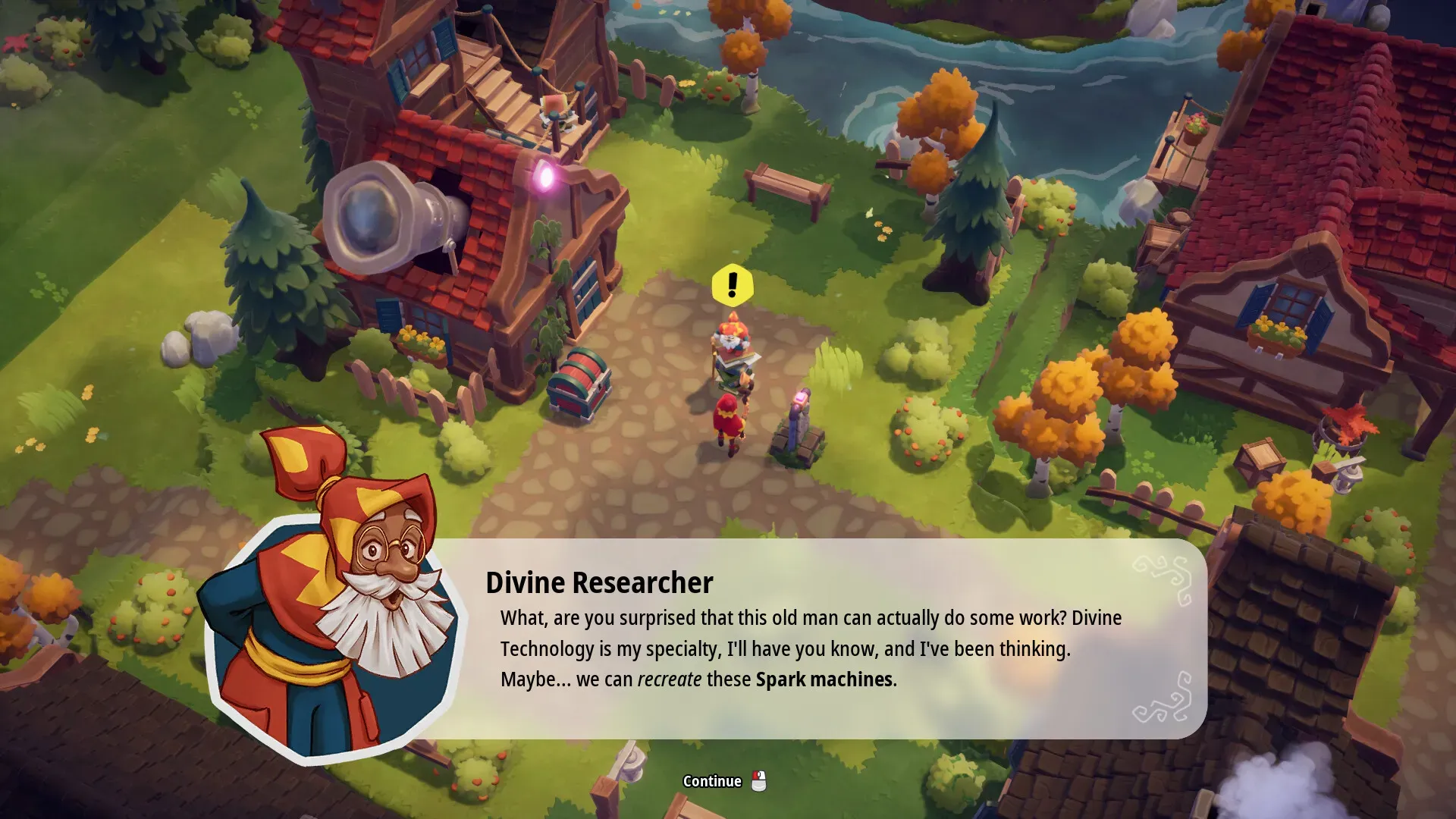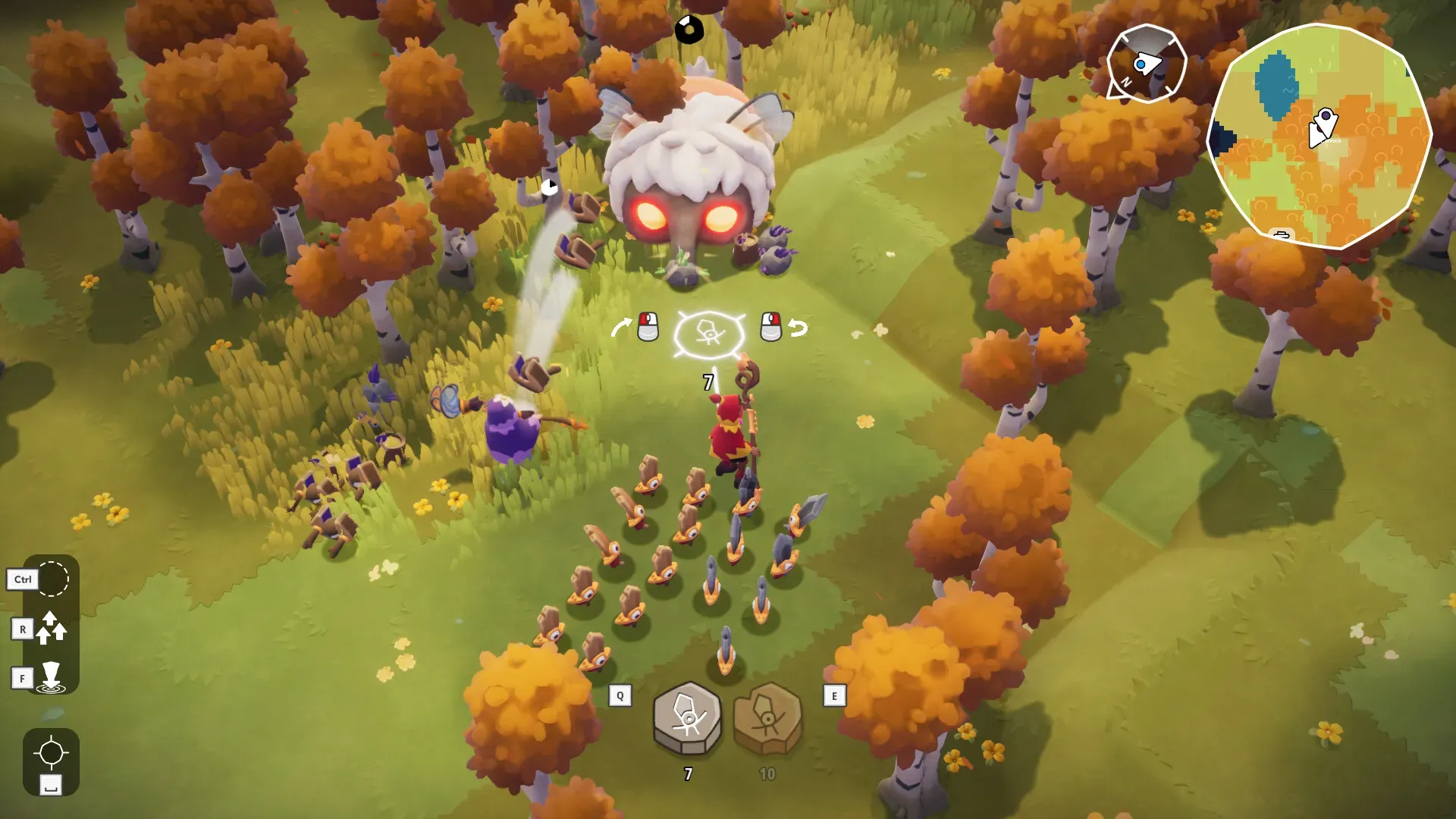When I first heard about Oddsparks and checked out its Steam page, I saw this comment: “Oddsparks is a casual yet intricate automation game that combines the serene exploration of Stardew Valley with the logistical challenges of Factorio”. Since these are two of my all-time favorite games, I was immediately intrigued.
Even though Oddsparks is a 3D game, the stylized art style reminds me of Stardew Valley. It’s warm and cozy, and the Sparks are very cute.
You start the game in a quaint little village, reminiscent of the town in Stardew Valley. It’s inhabited by a few NPCs, who, unlike their Stardew Valley counterparts, stay in front of their shops and don’t move around. As you explore beyond the borders of the village, you get to the procedurally generated main part of the game world. This is where you will discover Sparks, which will help automate complex production chains to progress through the game.
I played the already impressive early access version, and Oddsparks will be officially released on May 27th, 2025, with even more features.
Sparks
The namesake and main feature of the game are Sparks. They are very cute little creatures that help the player with all tasks in the game. While the player can harvest basic resources like small trees, stones, and bushes, everything else can only be collected with Sparks.
Your first Sparks aren’t very impressive, but as the game progresses, you will discover and unlock more specialized Sparks. They can haul more items, are faster workers, better fighters, and offer other more specialized skills like regrowing the natural vegetation or scouting the environment.

Quests
Progression is handled through quests. The village NPCs will give you quests that unlock additional Sparks, buildings, recipes, and more. Most of the quests require larger numbers of items, which incentivizes setting up automated production chains.
In addition to the quests, the village also has a monument that unlocks additional skills and features, similar to the community center in Stardew Valley. The monument tasks only ever require one instance of an item to unlock, so you don’t have to build any specialized production chains. You mostly acquire the necessary items while playing the game normally, but some items can be a bit harder to get, like drops from some of the stronger enemies in the game.

Automation
Setting up automation is essential to progressing through the game. Luckily, the process of automating basic items is very straightforward. All production buildings have to be manned by Sparks, with some being faster workers than others. Basic resources like wood and stone can be collected with special logging or mining buildings. However, these can only be placed on predefined resource nodes, so you may want to look for good locations to set up your base.
Most other production buildings can be placed anywhere on the map, with some exceptions like the Spark Workbench, which is only buildable on ancient foundations. I wasn’t a big fan of this because it artificially limits how you can design your production chains, and you have to scout the map to find good areas with resource nodes and ancient foundations nearby. While I never struggled with normal items, the quests that required greater numbers of Sparks were a bit grindy because the lack of foundations meant I couldn’t easily expand my Spark production.

Logistics
The logistics system in the game makes great use of the Spark mechanics. You build paths and assign Sparks to them, which will carry the items. You can also unlock useful path additions like splitters, crossings, filters, and more. I was able to design and build any path layout that I wanted, although admittedly, I haven’t designed any super compact and maximally efficient production chains yet.
Trains! Do I have to say more? At the beginning of the game, I was wondering how I could transport items over longer distances. Building a long and slow dirt path would be even worse than a long conveyor belt or pipe in Factorio, but luckily, the game also includes the many-wheeled wonders, which, of course, must be driven by a Spark.

Oddsparks also has a very sophisticated and in-depth logic system with a whole bunch of different sensors, logic gates, displays, and more, similar and probably equally as powerful as the circuits in Factorio. This is one part of the game that I haven’t explored in detail yet, it seems like you can design very advanced systems. The wireless senders and receivers, especially, seem very useful (just imagine how often wireless redstone would be handy in Minecraft).
Combat
You can only fight enemies with Sparks. The player character cannot fight at all, which makes a lot of sense in the overall context of the game. However, I didn’t enjoy fighting enemies in the game, as the combat requires a lot of micromanaging. Stronger monsters all need special tactics to be defeated. A common pattern is to command your Sparks to attack an enemy, and they will hit it once or twice each. Then the enemy stuns them, and you have to recall them to keep them alive. Repeat that a few times until the monster is dead.
At the same time, combat is necessary to progress. Many quests require drops from stronger enemies, although generally not that many. One of the last mobs I had to fight was too much of a challenge for me. After multiple attempts and many lost Sparks, I had to look at a guide, and even with that knowledge, it took multiple minutes to defeat each.
While the rest of the game is very relaxing, the combat can get stressful at times. Because of the limited number of Sparks you can have active at once, you cannot overwhelm any enemies with pure numbers. Thankfully, the enemies near the areas where you will likely set up your first production chains aren’t aggressive, so you don’t have to worry about constantly defending your base.

Customization
Oddsparks also has a plethora of customization options. Not only can you customize your character, you can also get a bunch of decorative buildings and items in the game. You can even repaint your buildings with a special Spark and paint, so your production lines can be efficient and good-looking.
Steam Deck Support
Since my GPU is slowly dying and getting a new one in the current GPU market would require me to win the lottery, I mostly played Oddsparks on my Steam Deck. The game is Steam Deck verified and runs great at around 50 FPS with native resolution and high settings. Even though I’m normally a mouse and keyboard player, I had no problems controlling the game with the controller.
I also played a bit on my laptop, but the performance wasn’t as good, which is to be expected without a dedicated graphics card.

Overall, I had a good time with Oddsparks. It’s a cozy and cute automation game that’s very relaxing to play after work. Micromanaging the Sparks when fighting stronger enemies was the only stressful part, and I would like to see fewer placement restrictions on the Spark production buildings. Sadly, the full release will break my save game, but I will probably return after its official release; maybe I’ll even find some friends to play the game in multiplayer.
Is Oddsparks as good as Stardew Valley or Factorio? No, not quite, at least not yet, but even the early release version I played was very polished and had a lot of content. Oddsparks’ official release adds even more features, including a whole new biome, and the developers have teased in their release announcement that they will continue to work on the game.
